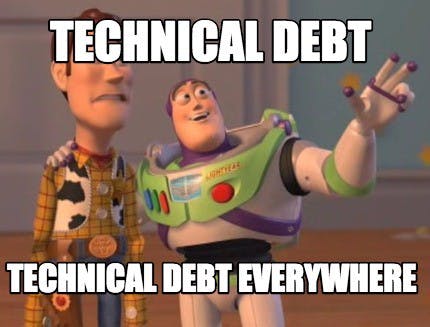Preventing Technical Debt is what allows the development or managing of the product to be agile in the long run.
The above quote becomes even more relatable when we see growth stage startups investing a pretty penny in their technical debt. Even if the company’s product is incredible and its marketing efforts are well appreciated, the mounting pressure of technical debt can tear an organization apart.

One thing that is mostly seen in tech startups is their urge to ship the product or MVP to market prematurely, without looking at all the other resources.
The real challenge that comes with ignoring technical debt is that companies will have to deal with the implication inevitably as they try to add new attributes to the product.
What is the exact meaning of technical debt?
The term technical debt refers to the extra work and costs the company has to pay later in product development as a result of choosing the ready-made and easy solution now, instead of a longer one that follows the coding best practices.

What is Tech Debt and what is not?
In my opinion tech debt is a set of known shortfalls in a codebase or architecture that are actively reducing the speed or scale of product development.
Some common causes foretell technical debt are.
Addition of new attributes in ongoing development
Insufficient upfront definition where requirements are still being defined during development or development starts before any design takes place.
An unreasonable deadline that pressures the team into a quick release.
Using a simpler or Low-code platform instead of an optimal one.
Low-quality software design decisions
Lack of coding skills
Lack of product ownership.

Below are some examples that occur in growth-stage startups that lead to Technical Debt:
Depending on a rigid architecture that is not keeping up with growth in team size and user database.
A key code flow that isn’t well transferrable and thus engineers find it inconvenient to make changes.
A feature that went redundant, leading to considerable ongoing engineering investment hard to maintain.
Choosing a WRONG or UNSCALABLE Tech stack.
Here I want to highlight my Code Companion and Personal Coding Assistant “Codiga”

Codiga’s Coding Assistant tool lets you create, share, and import reusable code snippets in your IDE known as Smart Code Snippets. Users develop Smart Code Snippets and have the option of sharing them publicly on the platform. This means that any other developer can simply look for the code pattern and reuse them directly in their IDE with just a few short commands.
The main features Codiga has that I’m impressed with are
a) Context-based suggestions which suggest code snippets based on your language, filename, and dependencies.
b) Codiga is Enterprise Ready, so you can easily create and share code snippets safely within your team.
c) Codiga provides full privacy and security to your code.
d) And most important Codiga lets you create “Flexible and Scalable “ code for you and your team, thus helping to keep track and deal with the Technical Debt.
Their tool's performance is blazing fast, a request takes just a few milliseconds to come back, you can add your own code snippets, and more to it the tool is Open Source. Isn’t That’s DOPE!!!
The tool which I want to focus on is their Codiga hub, which helps coders easily browse, share, favorite, and copy Smart code Snippets from their Codiga database. With the use of Plugins, you can get code snippets directly in your IDE and Browser.
How Codiga Hub helps you code?
Codiga Hub tool helps you save time by providing you with prebuilt code snippets and helping you to focus more on the code logic.
You get code recommendations from experienced developers in the industry.
With Codiga, I’m able to code and deliver the requirements asap. The Codiga Hub helps me to keep track of my code quality, increased collaboration with my team, and increased overall productivity.
Read also: Top software engineer productivity tools for 2022
How do you usually find the technical debt?
The most common situation in which tech debt starts to be noticed is when a product or feature goes from trying to find product-market fit to finding it and entering a growth phase.
The most feasible way to find Technical debt is by getting user feedback in cyclic revision. I think this because the purpose of the product is to serve the user. If your UX is awkward or complicated, it may be the result of old technical debt.
Technical debt is the difference between what was promised and what was actually delivered.
How to Avoid Technical Debt?
Create proper documentation
Take advantage of agile practices
Trust your developers
Avoid the temptation to save time and money
Establish a good testing procedure
Set an annual system maintenance plan
Create an open communication system
Management of Technical Debt at scale:
While dealing with Tech Debt you should have Objective and Key Results(OKRs) or goals just like any product work or feature building. These OKRs should be reviewed exactly like any other product goals.
Allow some overall engineering time to focus on reducing tech debt. Once you start to set out a fraction of engineering time, it is no longer necessary to cross-prioritize across tech debt and product features; they are now in different prioritization buckets.
The product managers and other cross-functional leads should be bought into the plan, but the engineering lead should ultimately drive it.
The CTO or Head of Engineering should then hold regular reviews to track progress.
2 cents:
Emphasize technical debt in sprint planning just like your normal work. Try to avoid keeping it as a backlog or issue tracker.
When to start investing in Technical Debt?
I believe if your company or product is in survival mode it may not be the right time to worry about the tech debt. For example, your product might have yet to achieve product-market fit or gain traction. In this situation, you probably want to invest all your engineering time in achieving product goals.

How to keep Harmony between feature Development and Tech Debt?
- Invest in technical debt during the development phase
- Track the possibility of introducing new technical debt
Final thoughts: Dealing with tech debt takes large effort and proper team management. It is easy to neglect this error when your product seems to run fine but can prove costly in the long run if not invested at right time.
